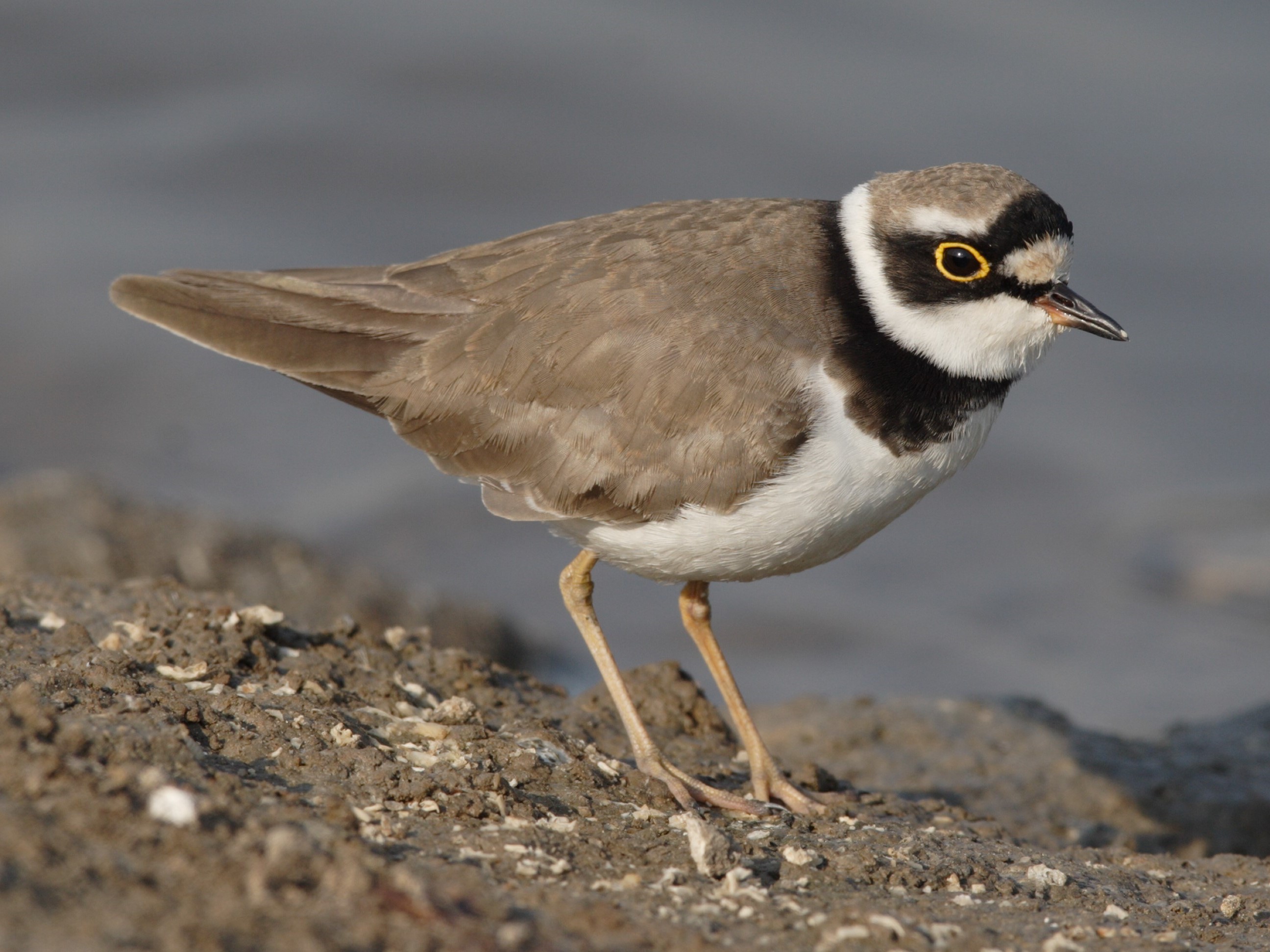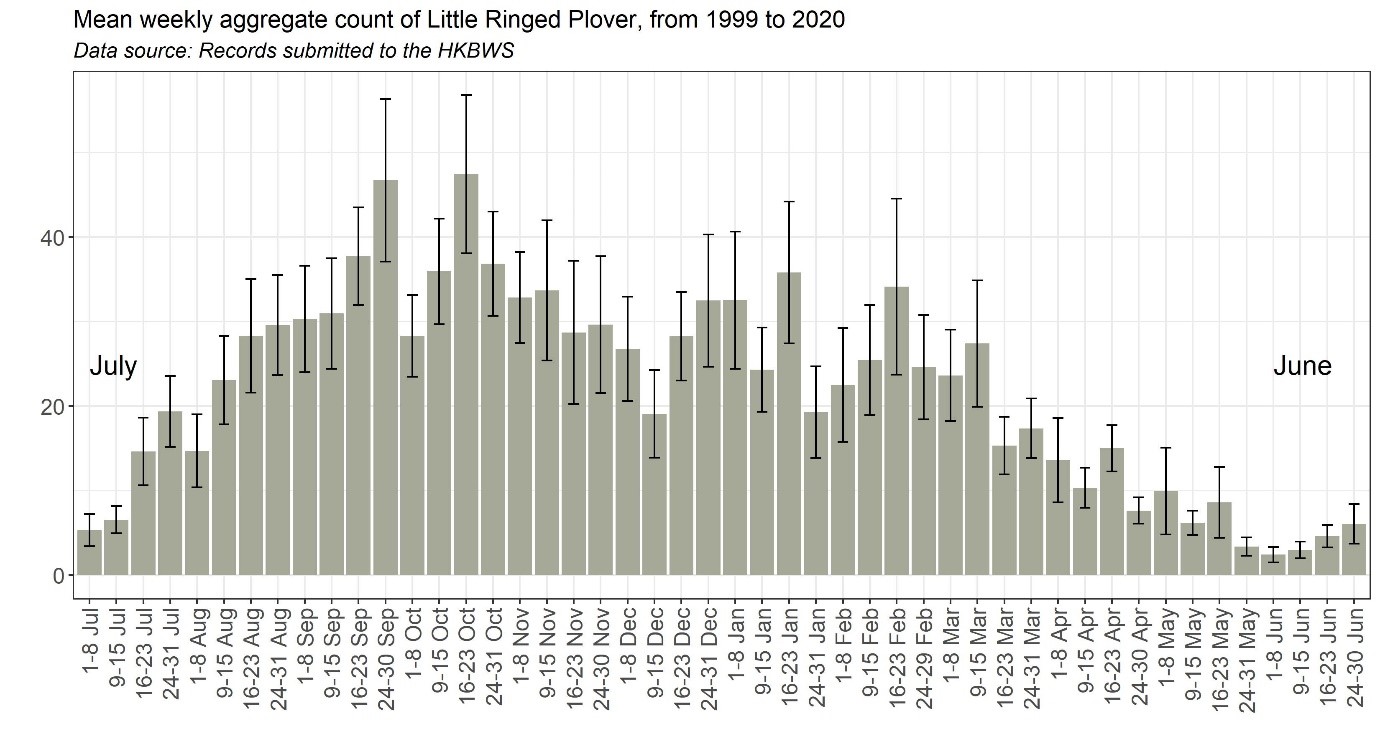Little Ringed Plover Charadrius dubius 金眶鴴
Category I. Present all year. Primarily an autumn passage migrant and winter visitor to fresh and brackish water wetlands but breeds in small numbers in ephemeral freshwater wetland habitat.
IDENTIFICATION

Dec. 2005, John and Jemi Holmes. Adult male.
14-17 cm. The default small plover on fish ponds and other fresh or brackish water habitat. In flight lacks wing bar. Adult has obvious yellow orbital ring around eye, well-marked black on head (particularly in male), largely black bill and pale legs; female and non-breeding plumage birds are duller with obvious brown in head pattern.

Sep. 2023, Paul Leader. First calendar-year.
First-calendar year birds have pale fringes to upperpart feathers, broken breast band, dull orbital ring and lack a clear cut supercilium. The pale fringes wear away as the winter progresses.
VOCALISATIONS
The typical call is a disyllabic ‘pooeep’, falling in pitch.
The alarm call is monosyllabic ‘tyoo’.
During aerial display when it circles around with rather staccato wing-beats it utters a measured somewhat buzzing note.
DISTRIBUTION & HABITAT PREFERENCE
Although there are reports from widespread areas, most records are from the northwest New Territories. Little Ringed Plovers occur throughout the year in low-lying areas with fresh or brackish water such as areas of wet agriculture, reclaimed land, freshwater marsh and fish pond areas. They rarely occur on open intertidal mudflats, though they do occur coastally where freshwater streams reach the shore.
OCCURRENCE
Autumn passage is evident in the third week of July, after which numbers increase to peak from the third week of September to the middle of November (Figure 1). The highest counts in that period are 221 on 5 November 1975 and 198 on 8 October 2017 (with a further 43 on the Shenzhen side of Deep Bay).
The highest numbers are recorded during the mid-January waterbird counts (Figure 2). The highest count is 340 on 13 January 1985 (with a further 16 recorded at Fu Tian, Shenzhen on the same date). Since then, however, there has been a long-term decline such that from winter 2010/11 to winter 2020/21 no more than 125 have been recorded.
The number of wintering birds declines from the middle of March, and numbers on spring passage are much lower than those in autumn, with the highest count being 123 on 28 March 1975, followed by 110 on 6 April 2007. Little Ringed Plover is least numerous during the summer when small numbers of presumed breeding birds are present.
At the former airport at Kai Tak where systematic counts were carried out during 1975-79, Little Ringed Plover was a passage migrant with substantially more birds in autumn. It was recorded in spring from the third week of February to the final week of June with peak numbers occurring during the first week of April. Autumn passage was noted from the third week of July to the first week of November with highest numbers occurring from the final week of September to the final week of October.
Little Ringed Plover was first reported in HK by Dove and Goodhart (1955) who found it a ‘fairly common passage migrant and occasional winter visitor’. Macfarlane and Macdonald (1966) noted there were records in every month of the year, though especially during the migration seasons.
BREEDING
The first probable breeding attempt was described by Melville (1980), since when it has bred in widespread low-lying locations throughout HK, including industrial estates, the present airport at Chek Lap Kok when there were large areas of temporarily unused land in the early operational period, Tuen Mun, Mai Po, Sai Kung, Cheung Shu Tan and Tin Shui Wai. It generally occurs on reclaimed, infilled or temporarily cleared land where the level, open aspect and poor drainage suit its requirements. Behaviour indicating breeding has also been noted at drained fish ponds and reservoirs.
Display has been noted in January and February, copulation from 9 April to 18 May, active nests and/or eggs from 17 April to 20 June and dependent juveniles from 31 March to 19 June. The HK breeding population appears to be relatively isolated from other breeding birds as Liu and Chen (2020) indicate it to be only a winter visitor to the coastal provinces of south China.
BEHAVIOUR, FORAGING & DIET
Unlike Kentish Plover does not habitually form large flocks though birds gather on drained fish ponds to forage. Otherwise occurs in small groups, often on the muddy margins of fish ponds or freshwater wetlands.
RANGE & SYSTEMATICS
Breeds south of the Arctic Circle to 25oN from United Kingdom east across Eurasia as far as Japan; winters across the central part of Africa, the Indian subcontinent, Indochina, south China, southeast Asia and Indonesia (Wiersma et al. 2020). In China a summer visitor to the northwest, north, northeast and east, and a winter visitor to the southern coastal provinces, including Hainan and Taiwan (Liu and Chen 2021).
Three subspecies are recognised of which C. d. jerdoni occurs from India east to Indochina and south China. Cheng (1987) stated that jerdoni occurs in southwest China, and that C. d. curonicus occurs in northeast, north and west central China in the summer and in south China in the winter. Melville (1980) suggested that birds occurring at the former airport at Kai Tak were curonicus; however, the sample size was small. It is likely that curonicus occurs here on migration or in winter, as it occurs in north and east Asia. A bird ringed in Taiwan was caught here on 7 September 2014. The nominate subspecies occurs to the from the Philippines to New Guinea and the Bismarck Archipelago.
CONSERVATION STATUS
IUCN: Least Concern. Population trend stable.
Figure 1.

Figure 2.

Cheng, T. H. (1987). A Synopsis of the Avifauna of China. Science Press, Beijing.
Dove, R. S. and H. J. Goodhart (1955). Field observations from the Colony of Hong Kong. Ibis 97: 311-340.
Liu, Y. and S. H. Chen (eds) (2021). The CNG Field Guide to the Birds of China (in Chinese). Hunan Science and Technology Publication House, Changsha.
Macfarlane, A. M. and A. D. Macdonald, revised by Caunter, J. R. L. and A. M. Macfarlane (1966). An Annotated Check-list of the Birds of Hong Kong. Hong Kong Bird Watching Society, Hong Kong.
Melville, D. S. (1980). Probable breeding attempt by the Little Ringed Plover in Hong Kong. Hong Kong Bird Report 1978: 42-47.
Wiersma, P., G. M. Kirwan, D. A. Christie, and P. F. D. Boesman (2020). Little Ringed Plover (Charadrius dubius), version 1.0. In Birds of the World (J. del Hoyo, A. Elliott, J. Sargatal, D. A. Christie, and E. de Juana, Editors). Cornell Lab of Ornithology, Ithaca, NY, USA. https://doi.org/10.2173/bow.lirplo.01

